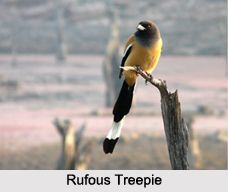 The Indian Subcontinent provides suitable habitats to various species of birds for residing and reproducing. Treepies are no exception in this regard. Grey Treepie and Rufous Treepie are the two treepies which have been recorded in India. They belong to the kingdom, Animalia; phylum, Chordata; class, Aves; order, Passeriformes; family, Corvidae; and genus, Dendrocitta. These treepies are described below.
The Indian Subcontinent provides suitable habitats to various species of birds for residing and reproducing. Treepies are no exception in this regard. Grey Treepie and Rufous Treepie are the two treepies which have been recorded in India. They belong to the kingdom, Animalia; phylum, Chordata; class, Aves; order, Passeriformes; family, Corvidae; and genus, Dendrocitta. These treepies are described below.
Rufous Treepie
Rufous Treepie is native to Indian Subcontinent. Its upperparts are rufescent-brown, whereas the under parts and lower back are warm tawny-brown to orange-brown in appearance. The head of the bird is sooty black in color and so are the breast and upper mantle. Also, its legs and feet are black. The blackish-grey bill can be described as stout and has a hooked tip and the color of the eyes ranges from deep red to reddish-brown. Its wing coverts are white and primaries are contrastingly black. The pale grey tail of the bird is long and graduated and has a wide terminal band. The length of this bird ranges from 46 to 50 cm and its weight ranges from 90 to130 g. Male and female Rufous Treepies are known to be similar. This treepie is an arboreal omnivore and depends on fruits, seeds, invertebrates, small reptiles and eggs and young of birds for survival. The breeding season of the bird in India ranges from April to June.
Grey Treepie
Grey Treepie has been recorded along the foothills of the Himalayas in the Indian Subcontinent, Eastern Ghats and north-east India. The crown and nape of the bird are grayish. Its bill is black in color and the eyes are red or reddish-brown in appearance. The face and throat are dark and black with a diffuse mask. The bird has brownish back and scapulars. The wing of the bird is black and has a prominent white carpal patch. The outer tail feathers and tips of the central feathers are also black in appearance. The underside of the bird is grey, but turns whiter towards the vent. The bird has blackish-brown legs. The length of this bird ranges from 36 to 40 cm and its weight ranges from 89 to 121 g. Male and female Grey Treepies are known to be similar. If the bird is duller with a browner nape and all of its feathers have rufous tips, then it is a juvenile. Grey Treepies are generally arboreal feeders, but will take some food from the ground, especially in cultivated regions. This bird depends on a wide range of insects and other invertebrates, berries, grain and other seeds, small reptiles, eggs, nestlings, etc for survival.



















